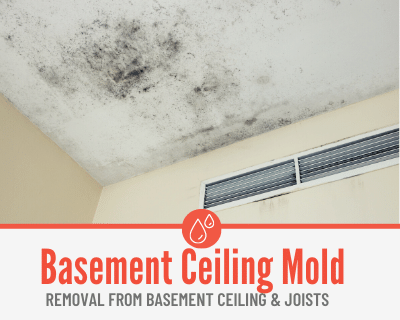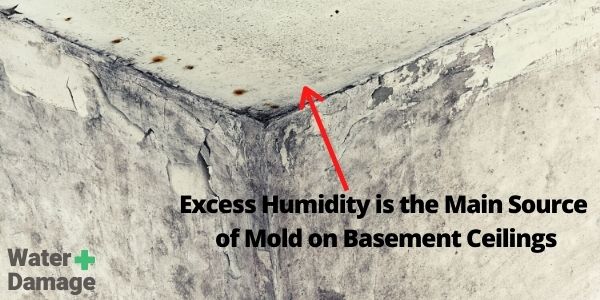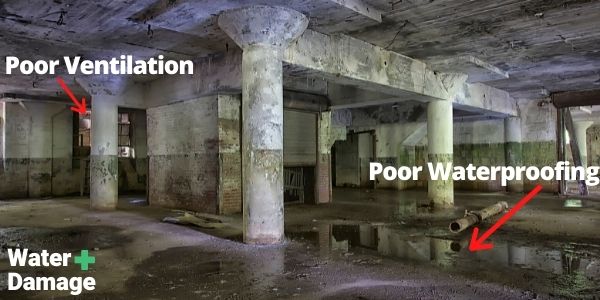Having problems with mold growing on your basement ceiling?
Not sure how to take care of mold inside your ceiling joists and insulation?
In this guide you will learn:
- How to determine if you have a mold infestation on your basement ceiling,
- Types of Mold Found on Basement Ceilings & Dangers of it,
- How to remove mold from basement ceiling & Prevent it from returning.

How to Tell if there is Mold on your Basement Ceiling
There are a few easy ways to tell if mold is beginning to grow, or has grown on your ceiling.
The telltale signs are:
- Visible water stains or condensation
- Discoloration on parts or all of your ceiling (White, Black and Green molds)
- Bubbling, peeling, or cracking of paint or wallpaper
Is Mold on the Basement Ceiling Dangerous?
Mold can definitely pose a risk to your overall health, especially if you have a pre-existing condition like asthma, or other acute respiratory illness.
Lack of ventilation inside the basement can pose an extra risk for humidity and space for mold to enter and grow quickly as moisture begins to condense.
Mold on your basement ceiling can not only be a risk to your health,but can also cause catastrophic damage to your ceiling joists.
Mold on your Basement Ceiling?
Call 844-488-0570 for a Risk Free estimate from a Licensed Mold Remediation Specialist in your area.
We Can Help Remove Mold from Basement Ceilings & Prevent it from growing again.
Types of Mold in Basement Ceiling
There are a variety of different types of mold that can be found growing on or in your basement ceiling. The three main types you will often see are white, black, and green molds.
White Mold
White mold is a term most commonly used to describe a mold white in appearance or with a powdery-like texture. cladosporium, penicillium, and aspergillus are the 3 main types of mold found in this category.
White mold can often mean the spores of the mold have no pigment and that is usually decided by the type of material or surface that the mold is growing on.
It’s important to note however that these species can also be found black and green in color, once the spores mature and develop their pigmentation.
Black Mold
Black mold is considered to be the most toxic form of mold, because it can produce mycotoxins harmful to human health, and should therefore be dealt with immediately when discovered.
Stachybotrys chartarum is the technical name for black mold, and comes with a very distinct musty smell that is noticeable right away.
Bathrooms and Basment ceilings are the most common places this mold can be found due to condensation, and it’s often caused by:
- Excessive humidity or warm temperatures
- Poor insulation of your Basement
- Dampness/Liquid moisture
- Long periods of darkness
- Water leakage
Green Mold
Green mold is soft & fuzzy or even powdery in appearance, and may closely resemble something such as moss.
Cladosporium, Aspergillus, and Penicillium are the most common forms of green mold after maturing, which also hold the potential to be slightly different in color with blue-green hues, or even olive green.
These molds still hold the potential to provide mycotoxins and be harmful to your health, it’s important to take care of them as soon as possible on your Basement Ceiling!
Why is there Mold on my Basement Ceiling?
Mold can often be found growing on your basement ceiling for one of two reasons; too much humidity in the air, or too much liquid moisture in the structure of your basement.

How to Remove Basement Ceiling Mold
You can remove basement ceiling mold in just a few steps if done properly.
- Remove the source of moisture from the basement ceiling. If you’ve noticed a leak, or an increase in humidity in your basement, it is crucial to remove this moisture source as soon as you possibly can.
A dehumidifier can tackle an increase in humidity, as well as proper ventilation (an open window or running fan system).
Should you come across a leak from a pipe or other water source, patch it to prevent any further moisture from getting onto your ceiling.
If you are unable to provide patchwork yourself, you may want to consult a professional about having them seal the leak or water source for you.
- Remove all visible mold growth & material. If you have a ceiling that is easily replaceable and not load bearing, such as ceiling tiles, it can be replaced with new material and swapped out to get rid of the bulk of the mold in a smooth transition.
Be sure to wear proper eyewear, a mask, and gloves at the minimum to reduce your exposure to the mold when performing tasks.
- Manually clean moldy material that cannot be easily replaced. Mold can be killed off with certain substances like bleach or vinegar.
You can use a mixture of one part bleach to ten parts water as a cleanser to eliminate mold by covering the affected area thoroughly. Wipe or scrape away the mold after allowing the bleach solution to set in.

OR
Put vinegar in a spray bottle and spray the mold affected area down. Allow the vinegar to sit on the mold for at least an hour. Wipe the area down clean with water afterwards, but ensure no moisture remains following the removal of the mold.
If after you have completed these steps and mold is still present, you may need to contact a professional in order to get it removed completely.
Need to Remove Mold from Basement Ceiling?
Call 844-488-0570 for a Risk Free estimate from a Licensed Mold Removal Specialist in your area.
We Can Help Remove the Mold & Prevent it from growing again.
Mold on Basement Ceiling Joists
The average basement ceiling joists are made from wood, which is a very porous building material that can allow for mositure to easily get trapped within its open space.
If you have found mold within your ceiling joists, it’s important to clean it out as soon as possible to prevent bodily harm.
What is Causing Mold on Joists?
The cause of mold on your ceiling joists can be found simply because of the lack of air circulation in your basement, or a leak or flood that has caused moisture to enter between the floors of your household.
Ceiling joists are normally an enclosed crawlspace with dark open area that is vulnerable to mold growth because it offers a welcoming breeding ground for spores.
Best Basement Ceiling Joist Mold Remover
The best mold remover for your basement ceiling is an antimicrobial cleaning agent. Solutions such as bleach, vinegar, ammonia, borax, and hydrogen peroxide are all valuable antimicrobial agents that are effective against killing off mold spores.
How to Remove Mold from Basement Ceiling Joists
The best way to remove mold from a ceiling joist is to first ensure that your basement floor and belongings are covered appropriately with a tarp or other proper covering. This is to be sure that the mold spores will not make contact with other parts of your basement.
A HEPA filtered air filtration system or HEPA vacuum is recommended as efficient equipment used to safely remove mold and spores in a contained room.
An antimicrobial solution is often used to best remove surface mold. Bleach or vinegar are common household items that are able to kill off mold spores.
Once sprayed on mold, allow the solution to soak in and eliminate spores. Then wipe away the excess with a wet rag. Ensure that no moisture remains after removal.
How do you Prevent Mold Growing on Basement Ceiling?
The best way to prevent mold from growing on your basement ceiling or between your main level floor is to ensure that the floor is properly sealed around it’s perimeter, and there are no visible cracks in between the flooring.
Reduce the amount of moisture that can enter your basement ceiling by insulating the space between the main level floor and basement ceiling.
Be sure that your basement does not hold a large amount of humidity by having proper ventilation or a dehumidifier if possible.

Best Mold Resistant Basement Ceiling Paints
There are a number of paints you can purchase that are specifically designed to be mold and mildew resistant. These paints often produce a waterproof layer of coating on your walls and ceiling, preventing moisture from entering the interior of your structures.
Look for labels such as fungicidal, waterproofing, or mold & mildew proof on the exterior label of your paint cans to know that it is confirmed to be mold resistant.
Brands like Kilz, Rust-Oleum, and Fiberlock are the most common brands used to effectively prevent mold and mildew from growing.
Will Plastic on Basement Ceilings Produce Mold?
Excess plastic on a basement ceiling, or plastic ceilings in general, can definitely produce mold if they are under the same moist conditions of humidity, condensation, or other liquid moisture.
No matter the material, it’s important to ensure it stays dry to prevent a breeding ground for mold and mildew.
Basement Ceiling Tile Mold
If you have mold on the tiles of your ceiling, it may be most wise to simply replace the affected tiles with new ones.
You can also go through the process of using an antimicrobial spray, however that does not guarantee a full removal of fungal spores from the area.
Basement Ceiling Insulation Mold
If you have discovered mold growing on the insulation inside your ceiling, it can be because of a source of moisture, or the mold growing on dust particles that have settled on your insulation.
Regardless of the cause, it still poses a problem and the insulation should be removed and replaced with new insulation, preferably mold resistant. This ensures that no leftover mold spores are present in your insulation and cannot regrow at the present time.
Mold Resistant Insulation for Basement Ceilings
There are specific types of insulation, like fibreglass insulation that are in fact naturally mold resistant, and can be beneficial if you’re struggling with mold problems on your basement ceiling.
Other kinds of insulation like spray foam insulation, or foam board insulation, are resistant to water making it harder for mold to form on them without proper moisture to grow from.
How Long Does it Take for Mold to Reach Your Basement Ceiling?
In the proper conditions of moisture and exposure, mold on your basement ceiling can begin germination and start growing as quickly as 24 to 48 hours after encountering a source of moisture.
Within about 3 to 12 days, the mold spores will start to colonize.
Finally in 18-21 days, the mold can become visible and be seen growing at a rapid rate on your ceiling or basement surface.
When to Call a Professional?
If you have tried all of these options and still have not been able to remove all of the mold from your basement ceiling, it’s time to contact a professional.
A mold Remediation company has industrial-grade equipment used to completely dry out your basement, remove existing mold and mildew buildup, and get rid of any remaining moisture to make sure that mold can’t spread further into your house.
We have Mold Remediation Technicians that can help get rid of mold available in 95% of USA
For Disasters of all Sizes
